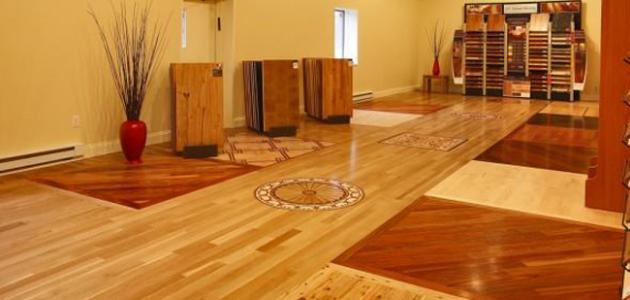Flooring types and materials | constguide.com
Flooring
The bottom, enclosed surface of indoor rooms is referred to as flooring. This might be a permanent covering laid over the floor or it can be an element of the floor construction, such as the upper surface of a concrete slab or floor slab. The term flooring can also refer to the process of laying down flooring materials.
types of floors
- Timber: One of the main advantages of choosing wood as a flooring is its unique look, which is due to the fact that each piece is unique. It can also be resilient, albeit it is prone to scratching and movement. Because wood is a sponge-like material, it may not be ideal for use in damp or damp rooms, though wood treatment can make it moisture resistant.
Wood flooring comes in a variety of finishes, including wax, oil, and varnish. The two most common forms of wood flooring are:
- Each board is crafted from a single piece of wood, which is usually 18-20mm thick and comes with a lover and a lover.
- Each board is ergonomically designed, with three or four layers of plywood glued together at right angles to make a 14mm thick board.
- Laminate: Laminate flooring is a pressed board of fibreboard that is covered with an image of a substance, such as wood, stone, or tile, and then protected with a coating. Laminate is a good option for spaces that want to benefit from the aesthetics of a "natural" floor. The high-quality laminate is durable and may have a 20-year warranty, it requires minimal maintenance, and it can be fitted with underfloor heating at a lower cost, with easy installation, and without the risk of damage from scratching. It is durable and may have a 20-year warranty, it requires minimal maintenance, and it can be fitted with underfloor heating.
- Vinyl: Vinyl flooring comes in rolls or tiles and is usually adhered to the floor. It comes in a wide selection of colours and sections, and it can be made to look like other materials, just like laminate flooring.
The following are some of the benefits of vinyl flooring:
-
It is irreversible.
- It is simple to clean and maintain.
- It can get wet without twisting, making it perfect for usage in bathrooms, kitchens, and other areas.
- Installation is simple.
- It can be reasonably priced.
- Bamboo: Bamboo is a renewable and water-resistant resource made up of woody sticks that have been pressed into the flooring material and connected or bonded together.
- Cork: Cork is a water-resistant, renewable material that may be used in a variety of applications, such as cellar fixtures and bathrooms. Cork can be bonded or nailed together in the same way that wood is. Cork flooring are warm and durable, but sharp things can easily destroy them.
- Tiles (porcelain or ceramic): Tiles come in a variety of colours, textures, shapes, and finishes. Their hardness makes them tough to scratch or bend, and they are also excellent for moist areas. However, they are difficult to instal and can break if there isn't enough support beneath them.
- Tile (Natural Stone): These are often more expensive than porcelain or ceramic choices, but they may be more appealing aesthetically. They must be carefully sealed initially placed, and this process will need to be performed on a regular basis to keep the tiles safe.
- Carpet: Carpet is made up of an upper layer of pile that is bonded to a backing. The pile is commonly made up of wool or heat-treated fibres like nylon, polyester, or polypropylene that are rolled into tufts or woven. There are many different types of top layers and styles to choose from. The carpets are generally resilient and easy to maintain and come in a variety of colours. Carpets are great heat and sound insulators, but they stain readily and are susceptible to water and moisture damage.
- Rubber: Rubber flooring made of natural or synthetic materials, including recycled rubber tyres, is classified as a resilient flooring because of its resilient or "rebound" properties, which makes it ideal for dance floors, restaurants, and other high-traffic areas where foot strain and slippage are a concern.
Rubber flooring has also been a popular alternative for household installations, where it is utilised in children's playrooms, shower rooms and bathrooms, garages, home gyms, and other areas where moisture and stain resistance, sound absorption, durability, flexibility, and temperature stability are required.
- Pouring Floors (Asphalt Mastic and Polymer): Asphalt mastic and polymer floors are poured as liquids and spread across surfaces to harden and cure. They are used in both commercial and residential applications where water protection and durability are important.
home flooring
It is more customary for home flooring to be put room by room rather than using a single material throughout because different rooms have varied flooring requirements, such as:
- Bedroom: Carpet is the most typical choice, but wood, laminate, and vinyl are also viable options.
- Kitchen: Vinyl is a popular choice since it is water resistant, easy to clean, and long-lasting. There are also tile and laminate flooring possibilities.
- The flooring choice in the lounge/dining room will most likely be based on aesthetic choices, as all forms of flooring are viable.
- Stairs: Where inhabitants are likely to move around without shoes and hard floors may be noisy, the bulk of upper spaces are carpeted.
- Bathroom: Untreated wood is not good for these spaces, and carpet can become damp and filthy. Vinyl and tile, on the other hand, are great since they are impervious to water and require no upkeep. High quality vinyl with a R10 grade is slip resistant, making it ideal for wet rooms.
Flooring for shops and factories
vinyl
It is easy to maintain, and unlike tile floors, there is no grout, which means it is good for hygiene, making it a popular choice for hospitals, nursing homes, and other facilities. Vinyl is suitable for a wide range of commercial locations due to its high wear quality and ability to handle huge quantities of foot activity.
Flooring that is safe
Since slipping is the most common cause of workplace injuries and trips and falls, the slip-resistant quality of this flooring makes it suitable for many workplace environments. This is a type of resilient, heavy duty, high quality vinyl or rubber flooring with slip resistant grit included, essential for many industries to create a safe work environment, these floors are easy to maintain and keep clean.






Please Login to Post a Comment
Login Register